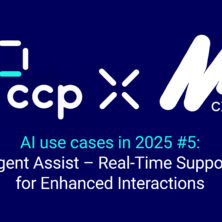
Agents often juggle multiple tasks during customer interactions, from information retrieval across systems, to research perhaps through search engines, and data entry to note-taking in CRMs and/or admin systems. Not to mention holding a conversation where they are listening and responding as naturally as possible. It’s a lot to ask while also ‘being present’ with the customer. The opportunity for errors and a sub-par conversation is obvious.
AI-driven hands-free conversations are designed to remove everything other than the conversation from the agent’s to do list.
What is the AI doing in Hands-free Conversations?
This again builds on the previous use cases as a good starting point. Think right back to use case 1 – autowrap, where the AI summarises call notes, and can either simply be copied and pasted into the CRM by the agent, or automated through deep integrations.
Imagine then a world, where not only does the AI do this, but it also navigates you though CRM screens as well as other platforms and apps, retrieving customer records and auto-populating information as you go. Meanwhile use case 5 – agent assist, is popping up with useful prompts to guide the call. Science fiction? Or science fact. The reality is that this is a genuine use case of today.
Key Benefits of Hands-Free Conversations: Absolute focus on the call
A truly liberating experience, the agent is focused solely on their conversation with the customer, while being fed the information they need to support the call and without worrying about what they are capturing as the AI is listening and interpreting to do that on their behalf.
The agent can listen intently, truly process the query and be mentally available to deliver responses where they’ve had the headspace to consider its appropriateness and the style of their delivery. Placing the human interaction at the very centre of the call to the exclusion of all other noise is extremely valuable when it comes to resolving that customer’s needs.
Reduced time spent on admin
If you were to say 10-20% of an agent’s time on a call is just typing and clicking to enter information and navigate screens, while a slightly arbitrary number, it’s inevitably slowing the call and reducing its value to the customer as the agent fills to give themselves the time to type.
Reduced keying errors
As the AI takes care of data entry, there are fewer agent keying errors. Not only does this reduce time on corrections, assuming there are field validations in place, or time taken to later interpret poorly captured data, it improves data quality overall. A key requirement for better analysis, better AI, better compliance, and better future performance.
Improved accessibility
What’s more, hands-free conversations can enhance accessibility – acting as a reasonable adjustment for people with visual impairments or limited hand function.
Implementation Considerations
First, the deep integrations necessary to support hands free integrations take time and shouldn’t be underestimated. Which is in part why this is use case 6 of 7. Because there will need to be some AI maturity building already to ensure both support for and success for this use case. But assuming you have that, it’s a natural progression to freeing agents simply to support customers.
However, there is another school of thought. Where the AI simply deals with all of the legacy for you. Which means you simply live with the poor processes, old mainframe systems, disparate add-ons and Excel spreadsheets you currently have, but without having to interact with them. The savings of not dealing with those, and not having to learn complex keying procedures to get to the screen you want, would be phenomenal and free cash for investment elsewhere. Listen from around 45 minutes into the webinar for Jimmy’s slightly mind-blowing hot take.
Second, accuracy and model training is paramount, which means training and testing the models will also take time and effort. As with other use cases, you will need to develop your own views of what is acceptable
Third, while it sounds all-encompassing, you could consider running the trained model locally and therefore reduce the computational costs.
Measuring Success
The primary KPIs here sit in customer satisfaction, agent productivity/average handling time and data entry or processing error rates. Beyond those, agent job satisfaction can be measured through feedback, attrition rates, etc.
But by far the most interesting benefit is the absolute focus on the customer and the delivery of superior service that should translate through to customer lifetime value.
To find out more about how CCP can help you make the right technology choices, read more here or get in touch.
This series of articles is drawn from our webinar with Jimmy Hosang, CEO and co-founder at Mojo CX. We explored seven key use cases for AI in contact centres, starting from the easiest productivity gains to value generating applications. You can find a summary of all seven use cases here, or watch the webinar in full here.



